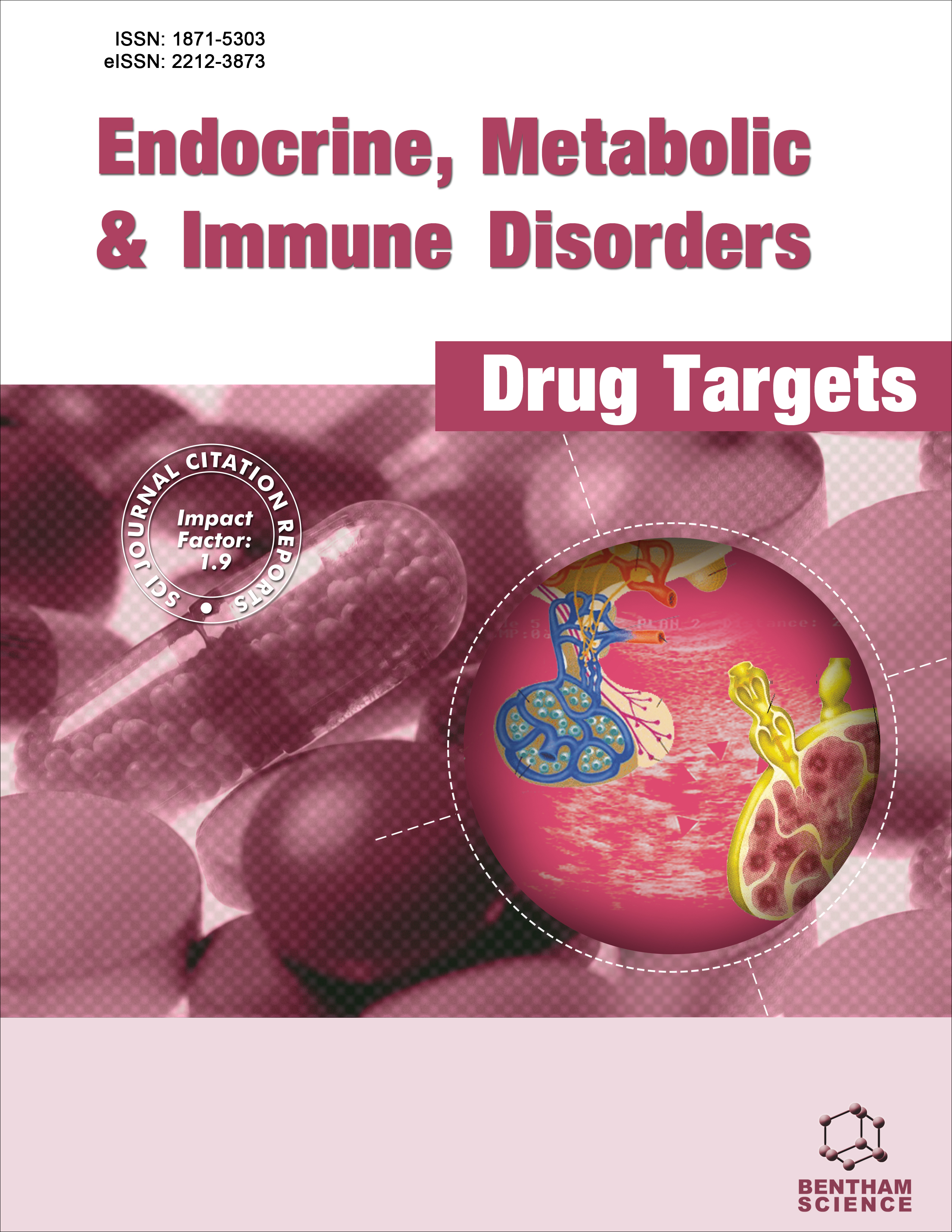- Home
- A-Z Publications
- Endocrine, Metabolic & Immune Disorders-Drug Targets (Formerly Current Drug Targets - Immune, Endocrine & Metabolic Disorders)
- Previous Issues
- Volume 23, Issue 14, 2023
Endocrine, Metabolic & Immune Disorders-Drug Targets (Formerly Current Drug Targets - Immune, Endocrine & Metabolic Disorders) - Volume 23, Issue 14, 2023
Volume 23, Issue 14, 2023
-
-
New Approach Methodologies in Immunotoxicology: Challenges and Opportunities
More LessAuthors: Ambra Maddalon, Martina Iulini, Gloria Melzi, Emanuela Corsini and Valentina GalbiatiTo maintain the integrity of an organism, a well-functioning immune system is essential. Immunity is dynamic, with constant surveillance needed to determine whether to initiate an immune response or to not respond. Both inappropriate immunostimulation and decreased immune response can be harmful to the host. A reduced immune response can lead to high susceptibility to cancer or infections, whereas an increased immun Read More
-
-
-
Mitotic Kinase Inhibitors as Therapeutic Interventions for Prostate Cancer: Evidence from In Vitro Studies
More LessAuthors: Aadil Javed, Gülseren Özduman, Sevda Altun, Doğan Duran, Dilan Yerli, Tilbe Özar, Faruk Şimşek and Kemal S. KorkmazProstate cancer is one of the devastating diseases characterized by genetic changes leading to uncontrolled growth and metastasis of the cells of the prostate gland and affects men worldwide. Conventional hormonal and chemotherapeutic agents are effective in mitigating the disease if diagnosed at an early stage. All dividing eukaryotic cells require mitotic progression for the maintenance of genomic integrity in progeny Read More
-
-
-
Human Liver Organoid Models for Assessment of Drug Toxicity at the Preclinical Stage
More LessAuthors: Mustafa Karabicici, Soheil Akbari, Ozge Ertem, Mukaddes Gumustekin and Esra ErdalThe hepatotoxicity of drugs is one of the leading causes of drug withdrawal from the pharmaceutical market and high drug attrition rates. Currently, the commonly used hepatocyte models include conventional hepatic cell lines and animal models, which cannot mimic human drug-induced liver injury (DILI) due to poorly defined dose-response relationships and/or lack of human-specific mechanisms of toxicity. In co Read More
-
-
-
Role of Oxidative Stress and Reactive Metabolites in Cytotoxicity & Mitotoxicity of Clozapine, Diclofenac and Nifedipine in CHO-K1 Cells In Vitro
More LessAuthors: Ali Ergüç, Fuat Karakuş, Ege Arzuk, Neliye Mutlu and Hilmi OrhanBackground: CHO-K1 cells were used as in vitro model to explore mechanisms of cytotoxicity of the test drugs. Aim: To provide in vitro data on toxicity mechanisms of clozapine, diclofenac and nifedipine. Objective: Cytotoxic mechanisms of clozapine (CLZ), diclofenac (DIC) and nifedipine (NIF) were studied in CHO-K1 cells in vitro. All three drugs induce adverse reactions in some patients with partially unknown mechanisms Read More
-
-
-
Evaluation of Endocrine Related Adverse Effects of Non-Endocrine Targeted Pharmaceuticals in Cellular Systems
More LessAuthors: Bita Entezari, Deniz Bozdag and Hande Gurer-OrhanBackground: Prenatal period is a critical developmental phase that is sensitive to hormonal disruption by natural and/or exogenous hormones. Some pharmaceuticals frequently prescribed and used safely during pregnancy are shown to interact with the developmental programming of fetus, resulting in endocrine-related adverse effects. Objective: In this research, we aimed to determine the endocrine disrupting potenti Read More
-
-
-
In Vitro Effects of Bisphenol Analogs on Immune Cells Activation and Th Differentiation
More LessAims: Investigate the immunomodulatory effects of bisphenols in the THP-1 cell line and peripheral blood mononuclear cells in response to lipopolysaccharide (LPS) activation or to phorbol 12-myristate 13-acetate (PMA) and ionomycin. Background: We have previously demonstrated the usefulness of the evaluation of RACK1 expression as a link between endocrine disrupting activity and the immunotoxic effect of xenobiot Read More
-
-
-
Effect of Notch Signal Pathway on Steroid Synthesis Enzymes in TM3 Cells
More LessAuthors: Hongdan Zhang, Wei Wang, Zaichao Wu, Yuxiang Zheng, Xiao Li, Suo Han, Jing Wang and Chunping ZhangBackground: Studies have indicated that the conservative Notch pathway contributes to steroid hormone synthesis in the ovaries; however, its role in hormone synthesis of the testis remains unclear. We have previously reported Notch 1, 2, and 3 to be expressed in murine Leydig cells and that inhibition of Notch signaling caused G0/G1 arrest in TM3 Leydig cells. Methods: In this study, we have further explored the effect of differ Read More
-
-
-
Case Report: Novel Pathogenic Variant Detected in Two Siblings with Type 1 Gaucher Disease
More LessAuthors: Huseyin Dursun, Kubra Metli and Fahri BayramBackground: Gaucher disease (GD) is an autosomal recessive lysosomal storage disease. The disease develops due to glucocerebrosidase enzyme deficiency caused by biallelic pathogenic variants in the glucosylceramidase beta 1 (GBA1) gene, which encodes the glucocerebrosidase enzyme. The GBA1 gene is located at chromosomal location 1q22 and consists of 11 exons. In this article, we report a novel pathogenic variant in Read More
-
Volumes & issues
-
Volume 25 (2025)
-
Volume 24 (2024)
-
Volume 23 (2023)
-
Volume 22 (2022)
-
Volume 21 (2021)
-
Volume 20 (2020)
-
Volume 19 (2019)
-
Volume 18 (2018)
-
Volume 17 (2017)
-
Volume 16 (2016)
-
Volume 15 (2015)
-
Volume 14 (2014)
-
Volume 13 (2013)
-
Volume 12 (2012)
-
Volume 11 (2011)
-
Volume 10 (2010)
-
Volume 9 (2009)
-
Volume 8 (2008)
-
Volume 7 (2007)
-
Volume 6 (2006)
Most Read This Month
Article
content/journals/emiddt
Journal
10
5
false
en


